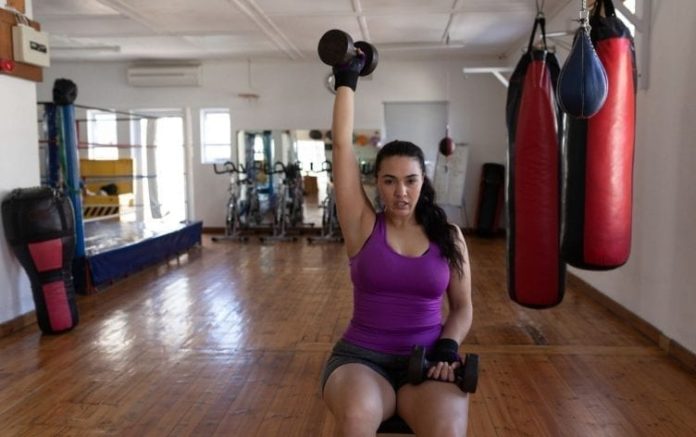
Quick: You have 30 minutes. You can either go for a walk or do a workout. If your goal is weight loss, which should you choose?
Anyone pressed for time, who’s also trying to increase their physical activity to lose weight, is familiar with this dilemma. There are only so many hours in the day, and sometimes, you just don’t have time to get both your steps and a workout under your belt. Of course, in an ideal world, you do both. However, if you only have time to do a general activity, like walking, or a purposeful workout, which should you choose?
To help you make an informed decision, we talked to fitness pros who help people reach their weight-loss goals every day. Here’s what they had to say:
THE CASE FOR WALKING
There are some pretty big benefits to walking regularly, especially if you want to lose weight.
It may help you burn more fat. “Walking, specifically in Zone 2 of your heart rate, helps teach your body to become more efficient at burning fat,” says Ramsey Bergeron, a certified personal trainer and owner of Bergeron Well-Being. For walking to be effective, you have to keep your heart rate under the threshold where your body switches fuel from fats to carbohydrates, which is usually referred to as Zone 2, and is approximately 60-70% of your max heart rate.
It may be easier to fit in and do consistently. “A major advantage of getting lots of walking while trying to lose weight is it doesn’t elevate our heart rate too high and can be done daily, resulting in greater caloric expenditure over time,” explains Keith Hodges, a certified personal trainer and founder of Mind In Muscle Coaching in Los Angeles. In other words, if you manage to walk a few times a day, you could end up burning more calories overall than you would with a 30-minute workout, which helps you toward your weight-loss goal. “It could be as simple as walking to work or parking further away from the door of a building or taking the stairs instead of the elevator or escalator,” says Hodges.
It’s beginner-friendly. “If you’re just starting, walking is better bang for your buck,” says Bergeron. This is particularly true if you haven’t done much physical activity recently. If you walk briskly, you’ll get your heart rate up and prepare yourself for more purposeful workouts, like running or weightlifting. “Movement, like walking, will also loosen you up, and it’s an important first step between desk jockey and a fitness icon,” he notes.
THE CASE FOR WORKING OUT
Of course, there are good reasons why purposeful workouts are considered a must for people who want to lose weight.
You’ll burn more calories in one session. Ultimately, weight loss comes down to calories in, calories out (although lots of different factors can affect both sides of the equation). Plain and simple, if you expend more calories than you take in, you lose weight, says Eric Madia, the head of sport science at the Sports Performance Lab. “We will naturally burn more calories in a training session than we would walking because we’ll be moving at higher intensities within the workout,” he explains.
Certain types of workouts build muscle and increase your metabolism. “If the goal is weight loss, HIIT, circuit training or heavy resistance training will be much more effective long-term than a 30-minute walk,” says Bergeron. There are two main reasons for this. First, these activities build muscle mass, which will help you burn more calories at rest. Second, when you’re done walking, your metabolism goes back to normal right away, he notes. “When you do an intense workout, your metabolism stays higher up to a few hours after the workout is done, meaning you continue to burn calories at an increased rate.”
HOW TO DECIDE
Ideally, you’d have both walking and working out in your routine. “The perfect blend for weight loss would be walking at least 30 minutes a day 5 days a week, and working out 3 days a week,” says Bergeron. You could play with the balance of the days depending on how much time you have, but experts agree both general activity like walking and purposeful workouts have their advantages and deserve a place in your activity lineup.
Not sure which workouts to do? The Workout Routine feature in your MyFitnessPal app will serve up some quick workouts you can try.
There are three big questions to ask yourself when deciding which type of activity to do on any given day:
What kind of activity did you do yesterday (or the day before)? If you walked yesterday, opt for a workout today, and vice versa. This way, you ensure you’re getting both types of activity into your routine.
Which activity do you feel like doing? Consistency is key, Madia says. Choosing the activity you actually want to do, whether it’s walking or working out, makes it more likely you’ll complete the routine — not just today, but also in the future.
Could you fit in both? Who says you can’t walk and work out in one session? Especially if you have 45 minutes or more. For instance, if you normally lift weights for your workout you could try the following:
- Walking before you weight train on some days
- Walking after you weight train on other days
- Walking only on the days you don’t weight-train
“This is key, because it will teach you how to learn about your body and establish a routine that works best for you,” says Hodges. “Trial and error are absolutely necessary for self-discovery.”
THE BOTTOM LINE
As long as you’re getting an overall mix of walking and workouts, you’re in good shape for weight loss, experts say. Plus, other factors may impact your weight-loss success more than your activity habits. “Weight loss is 70% nutrition and 30% exercise,” says Madia. “If you have a poor nutritional intake, you’re not going to be able to achieve your weight-loss goals.”
For his part, Hodges says sleep and recovery are also key: “I can’t emphasize how much rest is important to reducing body fat.” Especially if you’re short on time, your workouts may be more intense, which magnifies the need for rest and recovery. His advice? “Don’t forget to make sleep a priority.”
Make progress every day while you work on mini fitness and nutrition goals, like walking more steps or learning to track macros. Go to “Plans” in the MyFitnessPal app for daily coaching and easy-to-follow tasks to keep you motivated.










